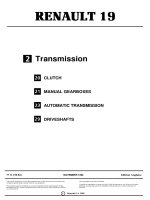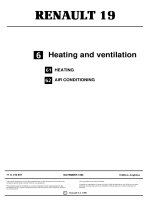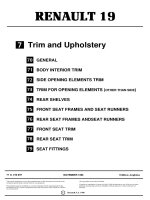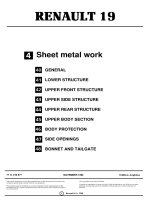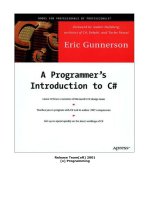Tài liệu Is your water safe to drink ? pptx
Bạn đang xem bản rút gọn của tài liệu. Xem và tải ngay bản đầy đủ của tài liệu tại đây (1.97 MB, 30 trang )
Acknowledgements
The Community Water Monitoring Guide is a tool to be used with the
Governing Water Guide, and has been
developed and trialled with communities, teachers and students through Live & Learn’s formal and
community education programmes.
Live & Learn Environmental Education acknowledges:
� The European Commission for support through The European Initiative for Democracy and Human
Rights Programme
� The Provincial and District Offices of Tailevu, Naitasiri, Serua, Ba, Ra, Macuata, Cakaudrove
and Bua provinces
� The Governing Water communities on Viti Levu and Vanua Levu
� World Health Organisation (South Pacific Regional Office); South Pacific Applied Geoscience
Commission; School of General Studies, Fiji Institute of Technology; and Institute of Applied
Sciences, University of the South Pacific
� The staff of the Kinoya National Water Quality Laboratory, Waila Pumping Station and Wailoku
Treatment Plant – PWD Water Supply
� Primary and Secondary School Teachers
Special acknowledgement to the late Mr. John Robinson, Environmental Cartoonist, Earth Warrior, in
recognition of his contribution to environmental education, conservation and community development!
What’s in the Community Water Monitoring Guide?
* Background information
* User-friendly instructions on how to use the H2S Test and Sanitary Survey to monitor drinking
water quality
* Tools: Result Card, Record Sheet, Sanitary Survey Sheets
Go through the Guide thoroughly before you begin working with your community group. We hope that this
Guide will be useful in motivating communities to monitor drinking water sources and promote better
sanitation, hygiene and access to safe drinking water.
Copyright © 2007 Live & Learn Environmental Education
Edited by Marie Fatiaki
Review Team: Kototuibou, S; Ravai, D; Bakaniceva, I; Ralulu, A
This material may be used for educational purposes but no part of this publication may be reprinted or
presented without prior written permission of Live & Learn Environmental Education, Fiji.
All enquiries should be addressed to:
Live & Learn Environmental Education
87 Gordon Street, Suva
Private Mail Bag
Ph: +679 331 5868; Fax: +679 330 5868
Email: Web: />Linking Knowledge To Change
Why test our water?
Unfortunately, pollution in water is sometimes difcult to detect. You cannot assume
that water is safe just
because it is clear.
Water that is odourless
and clear is not necessarily free from
contaminants or pollutants. If drinking
water is untreated or improperly treated
it may contain micro-organisms
(bacteria) that can cause the spread of
water-related diseases like diarrhoea,
typhoid and cholera.
There are many types of micro-
organisms on earth. Some are helpful
to humans, but others can cause people
to become sick. These organisms are so
small that we cannot see them, unless
we use a microscope.
INTRODUCTION
1
Why Community Water Monitoring?
Water monitoring can alert a community to contaminants in
time to prevent health problems! Community water monitoring
can help increase awareness and promote community actions
for “healthy water and healthy people”.
Community water monitoring encourages us to look at the role
we play in making sure that our drinking water is safe to drink
and how we can manage our water resources better.
Community-based water monitoring
INTRODUCTION
2
Is drinking untreated water the only way to get water-borne disease?
Using water that is untreated, or not properly treated
is not the only way we can get water-borne diseases.
Other ways like collection, storage and handling of
food, the disposal of human waste and the care of
children can cause diseases. It is a common belief
that children’s faeces are harmless, whereas in fact
they are the main source of infection to other children
(WHO, 1997).
Simple practices like washing of hands after visiting
the toilet, good disposal of wastewater and waste,
covering of food and boiling drinking water can help
prevent contamination and protect us from
water-borne diseases like typhoid and diarrhoea.
Did you know….?
Waterborne diseases are spread through the drinking of
contaminated water and food. About 80 percent (80%) of
all diseases are water-related.
In many cases, sewage gets into the water and spreads
disease. Also an infected person or animal may pass
pathogenic bacteria, viruses, or protozoa through their
waste into the water.
Because these micro-organisms that cause illness often
cannot be seen, smelled or tasted, contaminated water can
appear fresh and clean. This is a concern because
contaminations often go unnoticed until people start
seeing the doctor complaining of diarrhoea and other
water related diseases.
INTRODUCTION
3
The Hydrogen Sulphide Paper Strip Test (H
2
S Test) and Sanitary Surveys
These are water monitoring tools that can be easily used to monitor and maintain the quality of our water
supply.
The H
2
S Test was rst used in India to test for coliform or bacterial contamination in potable water. Since
then many more communities have used it globally and in Fiji and the Pacic region.
The advantage of the H
2
S Paper Strip test is that it is low-cost, does not require samples to be shipped or
refrigerated, it does not require a laboratory or expensive equipment, and most importantly, it is easy to
understand and carry out in the eld!
The Sanitary Surveys for rainwater tanks, piped water systems, wells, and drums, help communities to
check that their water sources are safe and free from contaminants. The Sanitary Surveys can be used with
or without the H
2
S Test, and does not need a laboratory to be able to identify sources of water
contamination and actions needed to address this.
Participation, Awareness, Action! H
2
S sample bottles
The well should be cleaned regularly
MONITORING TOOLS
4
How does the H
2
S Test work?
The H
2
S Test uses a paper strip to check for bacterial contamination in drinking water sources.
Coliform bacteria produce a gas called hydrogen sulphide (this is the gas that smells like rotten eggs).
In order to check for the presence of coliform bacteria in water, a water sample is added to the test bottle with
the paper strip. Chemicals have been mixed into a solution and placed on the paper strip. The paper strip will
react with the water sample by turning black if it comes into contact with hydrogen sulphide.
If the water sample or paper-strip turns black, this means that the water is contaminated.
H
2
S TEST
5
What can we use the H
2
S Test for?
1. For monitoring of rural and outer island water supply systems
where it may be difcult to conduct conventional testing due to
isolation or a lack of appropriate laboratory facilities.
2. For routine monitoring of reticulated systems; i.e. water that is
distributed through a piped system.
3. To identify if there is a need for further analysis of the water sample.
4. To determine the cleanliness of water storage tanks, rainwater
cisterns and other household storage containers.
5. To identify sources of contamination or the point in a piped system
where bacteria may be entering the water source.
6. To select which spring is best to develop.
7. To check how effective you have been in disinfecting a water source, or
to verify that a well has been properly protected.
8. As a tool in health and hygiene education to show villagers how
water becomes contaminated and what they can do about it.
9. For monitoring during emergencies and disasters such as cyclones
when water-borne diseases are more likely to occur and
conventional testing is difcult.
10. To demonstrate how easily hands become contaminated and how easily
they can contaminate food and water. For example, it can be used to
demonstrate the effectiveness of washing hand with soap; i.e. to
illustrate how bacteria can get from the hands to the mouth and into the
body. This is done by pouring clean water over unwashed hands and
testing it, and having others wash their hands with soap and repeating
the exercise.
H
2
S TEST
6
How do we carry out the H
2
S Test?
Step 1: Fill in the details
• Fill in sample number and date on the round sticker or
strip label and stick on the sample bottle (be careful not to
get the sticker wet).
• Record your sample number, date, time, location and
description of the water sampled on the Result Record Sheet.
• Record any other information e.g. turbidity, smell, source of
pollution, faulty pump etc.
Step 2: Collecting the control
• A control sample is used to compare the colour change in the
test samples, and to ensure that the sample bottles are not
contaminated before use.
• Collect a sample of uncontaminated water e.g. distilled
water, boiled water, bottled water, water treated with
chlorine. This is to be used as the control.
• There may be a slight change in the colour of the sample to
a pale yellow or light brown due to the colour change of the
reagent. This is normal.
Note!
u Do not open the test bottle until you are ready to ll them with your water
sample.
u Make sure that no contamination occurs e.g. by touching the mouth of the
bottle. Do not hold the test bottle cap from the inside.
INSTRUCTIONS
7
Step 3: Collecting the water sample
A. From the tap
• First clean the mouth or the outlet of the tap with a clean cloth.
• Turn on the tap and allow the water to ow for 15 to 20
seconds.
• Collect sample water from the tap by lling the sample bottle
up to the mark.
• Fill the test bottle carefully and slowly, this is because it will
ll very quickly to the marked line and may overow.
• If you do overll the bottle, do not spill the water out and do
not worry. Your result will still be valid.
• Immediately close the sample bottle.
B. From storage containers such as water tanks, and wells or
rivers
• Rinse the container to collect the water several times.
• Dip the container in the tank, well or river to collect a sample
of water then ll the test bottle up to the mark.
• Close the sample bottle, make sure that no contamination
occurs.
• Place all the test samples in a dark place at room temperature.
INSTRUCTIONS
8
Step 4: Check your results
• Check your test sample at the same time each day for 3 days for
changes in colour.
• Record the date and time for each observation on your recording
sheet and your result for each day.
• Compare the colour change with that of the control.
• Use the H
2
S Colour Code to indicate the degree of contamination.
Result Card
H
2
S Colour Code
(-) No change
(+) Slight change, the paper strip or water sample has turned
grey.
(++) The paper strip or water sample is partially black.
(+++) The paper strip and the water sample are noticeably black.
Note!
u Do not expose your bottles to direct sunlight. Store in a dark place. The sun’s
rays can kill the bacteria inside the test bottles and you will not get a true result.
CHECKING YOUR RESULTS
9
Note!
u Keep the test bottles stored away from children! Do not put them in a place
where a child can reach it.
u When you return the used test bottles, you will then get replacements.
u Do not open the used bottles!
Step 5: What do your results mean?
• (-) If there is no colour change after 3 days, this indicates that the water is clean and free from
bacterial contamination.
• (+) If the water sample or paper strip has turned grey there is a
possibility that bacteria is present in the water. Wait for a few
days and test a water sample again.
• (++) If the water sample or paper strip has turned partially black
then there is some amount of bacterial contamination in the
drinking water. Conduct a sanitary survey to check your water
source! Take action!
• (+++) If the paper strip and the water sample are noticeably black then there is a very high risk of
bacterial contamination in the drinking water, therefore, it is not safe for drinking.
Take immediate action!
• (+++) If there is a fast reaction, that is the water sample and paper strip turns black overnight, there
is a high probability of bacteria present. Your water is contaminated! You should clean out your
water storage containers, tanks or well and boil the water before you drink it. Use the
Sanitary Survey to check for the source of contamination and take action to eliminate this
contamination. Sample the water in your well, tanks and containers again after this to check the
water quality.
WHAT YOUR RESULTS MEAN?
10
